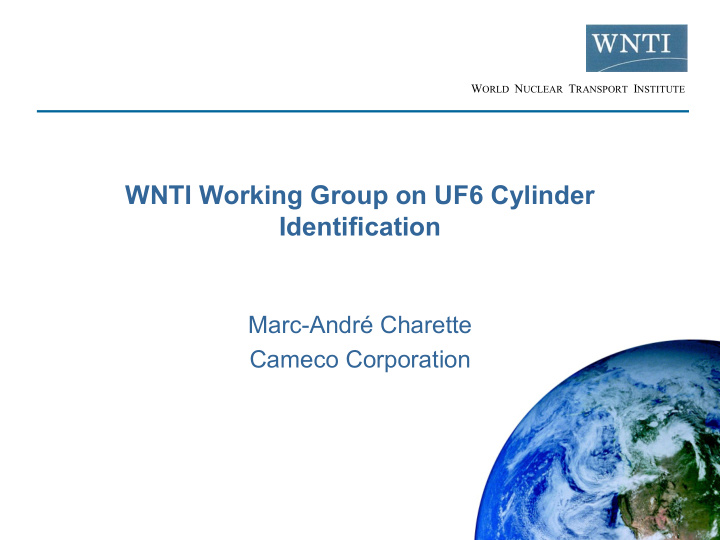



W ORLD N UCLEAR T RANSPORT I NSTITUTE WNTI Working Group on UF6 Cylinder Identification Marc-André Charette Cameco Corporation
UF6 Cylinders W ORLD N UCLEAR T RANSPORT I NSTITUTE • Standardized steel cylinders are used throughout the front end of the nuclear fuel cycle for processing, storage and transport of uranium hexafluoride (UF6) 30B Cylinder 48Y Cylinder
Cylinder Nameplates W ORLD N UCLEAR T RANSPORT I NSTITUTE • Fabrication standards require a nameplate containing identification and certification information be welded on the end of the cylinders – ANSI 14.1 – ISO 7165
Challenges with Reading Nameplates W ORLD N UCLEAR T RANSPORT I NSTITUTE • ANSI 14.1 and ISO-7165 standards require a punched or engraved serial number, but … – Characters only have to be 7 mm (9/32 inch) high – No requirement for a specific format for identification – No requirement for uniqueness across industry – No requirement for automated reading capability (e.g., barcode) • Reading serial numbers in the field can be difficult – Small lettering (height) can lead to confusion of letters and numbers – Nameplates deteriorate over time
Supplemental Labels W ORLD N UCLEAR T RANSPORT I NSTITUTE • Industry applies supplemental identification markings and labels.
First Stakeholder Meeting W ORLD N UCLEAR T RANSPORT I NSTITUTE • First UF 6 Cylinder Stakeholder Meeting was held in Washington DC, April 29-30, 2014. • Approximately 35 attendees Industry – TAM NNSA – AREVA – URENCO Inspectorates – Cameco – Worthington – ABACC – EDF Regulators – IAEA – INVAP – NRC – NAC International – CNSC
Creation of WNTI Work Group W ORLD N UCLEAR T RANSPORT I NSTITUTE • In May 2014, the Secretary General of the World Nuclear Transport Institute (WNTI) welcomed the creation of a special working group to focus on the identification of UF 6 cylinders. – www.wnti.co.uk/ • Scope: – Establish an industry-wide identification format that provides for uniquely identifying UF 6 cylinders and investigate methods for making the unique identifier (UID) machine-readable (e.g., barcode) and independently verifiable by the International Atomic Energy Agency (IAEA)
Working Group Members W ORLD N UCLEAR T RANSPORT I NSTITUTE • AREVA NC • Nantong CIMC Tank Equipment Co • AREVA TN • Nuclear Fuel Transport Co. • Cameco (NFT) • Centrus Energy Corp. • Oak Ridge National Lab • Columbiana Hi Tech • TAM International (US) Inc • Daher-NCS • TENEX • Electricité de France • URENCO Ltd • Global Nuclear Fuel • Westinghouse • Honeywell • Worthington Industries • JNFL • WNTI
Working Group Objectives W ORLD N UCLEAR T RANSPORT I NSTITUTE • Objectives – Establish a standard format (or set of formats) for the identification number engraved on the nameplates or a supplementary plate affixed to model 30B and 48Y cylinder – Develop a Requirements Document for applying a machine readable standard identification number to model 30B and 48Y cylinders – Investigate methods for adding a machine readable identification number onto the cylinders – Work with IAEA on an application method that may also satisfy IAEA requirements for authentication.
Overlapping Benefits W ORLD N UCLEAR T RANSPORT I NSTITUTE Operators Inspectorates • Less confusion about • Improved process • Higher confidence in multiple markings controls identifying cylinders • Fewer transcription • Consistent • Improved capability to errors paperwork & identify diversion or improved reporting undeclared material • Quicker/more efficient inventory • Eliminates need for • Easier to reconcile multiple markings transfers between • Reduced radiation countries dose
Example Unique Identifiers (UID) W ORLD N UCLEAR T RANSPORT I NSTITUTE • Standardized format/design • Unique across all industry • Machine readable (from a distance) • Usable by both the operator and IAEA
Recommended Requirements W ORLD N UCLEAR T RANSPORT I NSTITUTE • Functional and performance requirements: – A standardized lettering/numbering format/design – Not duplicated across industry – Large enough to be visually read from a distance – Capability to be remotely read (i.e., machine readable) – Withstand environment conditions in transport and use. – Withstand the operating practices. – Last the entire cylinder life, typically 40 years. – Reasonable application and maintenance costs. – Compliance with the requirements of the IAEA and EURATOM.
Recommended Requirements W ORLD N UCLEAR T RANSPORT I NSTITUTE • Additional features could enable the international inspectorates (e.g., IAEA, EURATOM, etc.) to fully take advantage of the identifier for safeguards purposes. – Identifier is applied in a tamper-indicating manner. – Characteristic of the identifier enable inspectorates to authenticate its authenticity. • The IAEA has determined that unique identifiers with tamper indicating features would provide them the opportunity to improve the effectiveness and efficiency of verification activities at both the facility and state levels.
Published Standard W ORLD N UCLEAR T RANSPORT I NSTITUTE • The WNTI Standard – UF6 Cylinder Identification – Posted on the WNTI website in June 2017 – Can be downloaded for free
Next Steps W ORLD N UCLEAR T RANSPORT I NSTITUTE • Implementation strategy – Global identifier would be installed on new cylinders during the fabrication process prior to cylinder certification. – Given the 20,000 plus cylinders in active service, identifier could be installed on existing cylinders during the re- certification process • Industry working on implementation plan – Legacy cylinders at the discretion of the owner.
Summary W ORLD N UCLEAR T RANSPORT I NSTITUTE • WNTI working group lead the effort on UID format and machine-readability capability – Opportunity to provide input to maximize benefit to IAEA • Frequent and interactive engagement with stakeholders significantly improved concept development • Incremental benefits can be realized by operators, regulators, and inspectorates • Start the implementation of the standard
Recommend
More recommend